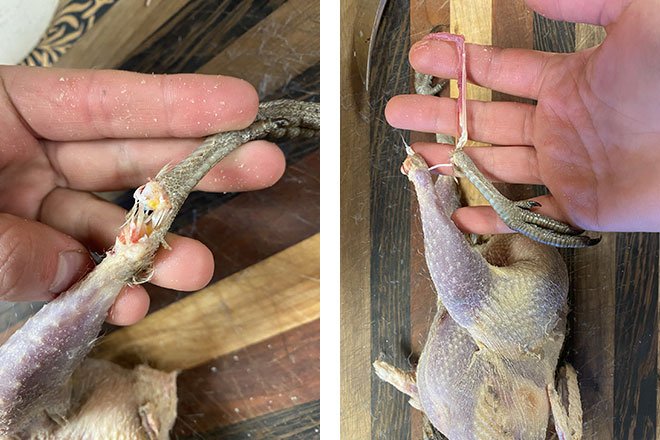How to Pluck a Hungarian Partridge
Cleaning your Hun back at home
Feeling ambitious? Plucking your bird is a terrific option which keeps the skin intact allowing for even more flavor when you’re ready to cook your bird! But you’ll have to prepare to settle in, as patience is one of the main tools needed as you work with the bird’s relatively thin skin.
In this guide, we will walk readers through the method known as dry plucking.
What you’ll need:
- Upland bird (Hungarian partridge shown for the purpose of this demonstration)
- Game Shears
- Patience
*A Special note: We are walking through this example with the focus on the hunter being back at home. If this method is utilized in the field, ensure you know and follow proper state regulations for transporting your bird.
The break down:
1Plucking should be a quick, jerky movement vs pulling. Pulling will increase the risk of tearing the skin. Grasp the feather (one or only a couple at most) and quickly snap it away from the body. It helps to hold the bird (and skin) down with the other hand to create tension for the perfect pluck. When selecting a bird for plucking, try to choose a bird with minimal shot damage so skin remains intact, and the bird is easier to work with. Many hunters and wild game chefs recommend aging their birds for 3-5 days prior to plucking, but they can be plucked the day of if necessary.
2Begin by plucking each individual leg above the joint and work up towards the body:
3Don’t forget the wings. When plucking these feathers, make those quick movements and ensure you provide counter pressure with your other hand to minimize the risk of tearing the skin:
4From the wings, work toward plucking the back of the bird:
5Last, but not least, pluck the breast area. Remember to take your time. It’s easy to rush here as you near completion!
.jpg.aspx)
6Snap the leg joints (or use game shears to create a partial cut) to allow for tendons to be removed.

7Remove the neck and head where the neck meets the base of the body. Game shears will also be utilized here.
.jpg.aspx)
8Remove the tail feathers by grasping them at the base and pulling individually. Set feathers aside if you wish to keep these for later. If desired, a lighter can be utilized to help remove any small feathers left behind after the plucking process.
9After your bird is adequately plucked, proceed to removing the internal organs. Grasp the lower portion of the breastbone and make a cut to provide access to internal organs. This will create a large opening where the internal organs can be removed and tossed or kept for eating (i.e., the heart).
.jpg.aspx)
10After removing the organs and smaller feathers, rinse your bird thoroughly. Bon Appetit!